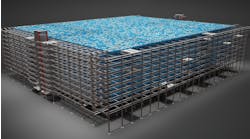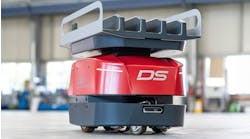The semiconductor chip shortage has drawn significant attention, and for good reason. Simply put, a growing list of products on the market today are dependent on chipsets to offer key differentiators.
Unfortunately, the demand for chips does not seem to be waning – quite the opposite in fact. For instance, global tech market advisory firm ABI Research finds other key users for chipsets, the consumer robotics and smart appliance market will generate US$80 billion in revenues in 2021, up a whopping 40% over 2020 revenues.
What does this mean for manufacturers? Ocala, Florida-based E-One is a prime example. E-One produces fire trucks as well as special operational vehicles common at airports or within forestry environments.
Richard Knutz, E-One’s director of planning and materials tells IndustryWeek, having the right tools in place serves as a foundation. “Fortunately, we have not experienced too many issues, mainly because we have the ability to look out into the future,” says Knutz, who implemented LeanDNA in 2019. “Due to the size of our backlog, we capitalize on the ability to project up-coming demand based on statistical analysis. We're able to give the information to suppliers, well in advance, which often leaves us in a positive situation.”
There's a couple of current trends influencing the need for better visibility, explains LeanDNA CEO Richard Lebovitz. “We are seeing a lot of growth in product customization,” he says. This is quite noticeable in E-One's case, with an array of dials, gauges, and components not only unique to a fire truck but also very specific to each of E-One's customers.
The other trend is the growing reliance on expanded supply chains to source componentry rather than attempting to build everything in-house.
Of course, complications exist when dealing with a high degree of customization from unit to unit, while at the same time dealing with a lot of global suppliers.
“What we do analytically is provide tools to help companies better identify the parts that could be short on a unit-by-unit basis,” says Lebovitz. “This enables manufacturers like E-One to collaborate with suppliers to actually get commitments on specific parts. Also, how do we get the safety stock set right based on a lot of these parameters in analytics? If this part has a min/max reorder point, what's the right trigger? This information is crucial in helping predict potential shortages, while also helping get the optimal level of inventory on a part-by-part basis despite complex parameters.”
Being Prepared
The first step is to prioritize the most critical actions. Of course, prioritizing actions is difficult without clarity and visibility. Receiving hundreds of sometimes difficult-to-understand messages from a system actually causes more confusion.
“When dealing with potential shortages, we have the ability to generate clarity and ultimately prioritize around anything that could actually impact an order or shipment," says Knutz. "The platform creates very standard ways in which supply chains can work day-to-day including best practices dashboards, and then workflow around these actions to make it easy to not only identify the five or 10 things to work on, but also make sure that those things are actually completed.”
For this type of process to work, there needs to trust in the data to ensure accurate results from complex analytics. "The communication to our suppliers has increased exponentially both in the data-cleanup and integrity," says Knutz. "This is crucial in influencing our ability to accurately forecast, especially when we're dependent on a commodity that is six to 12 months into the future. That's the line of sight that we give our suppliers that did not exist before, and ultimately helps us mitigates any shortages."










